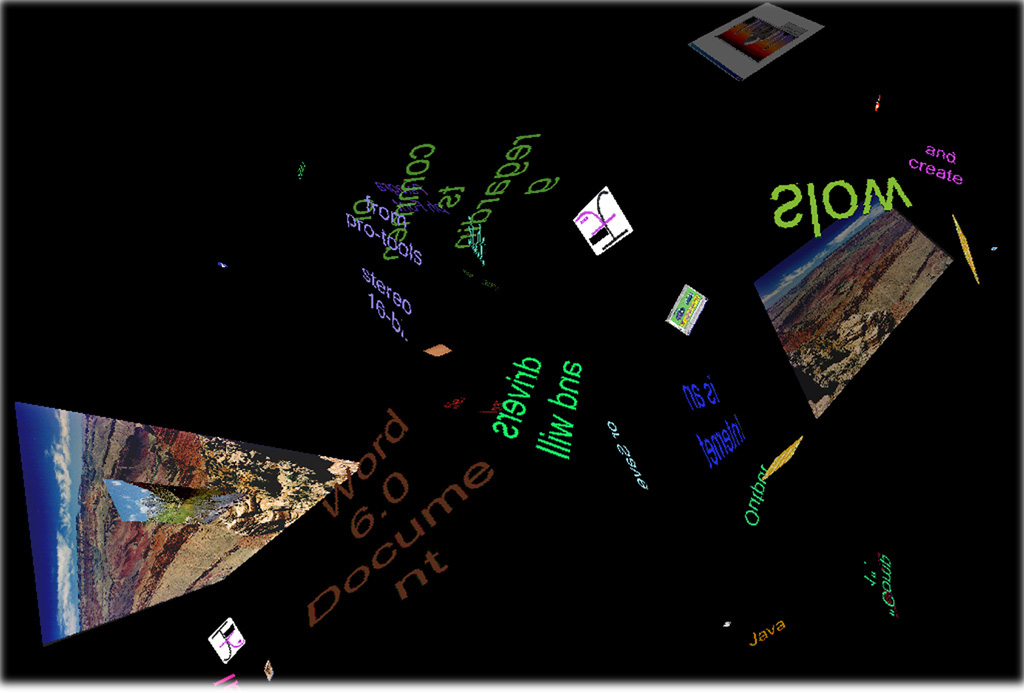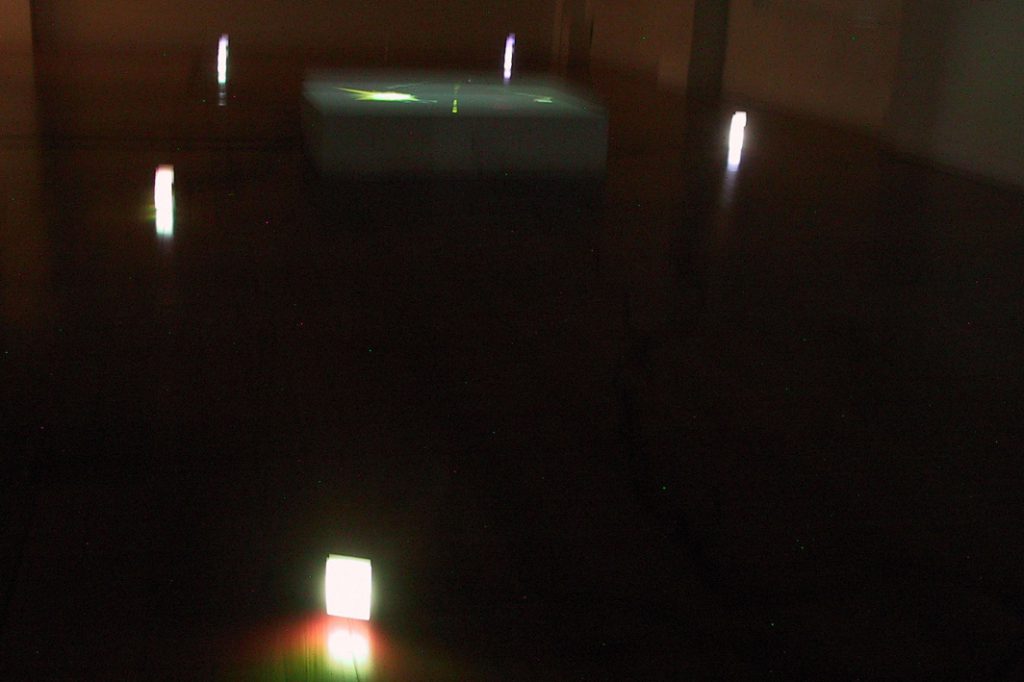





Video
[phage]
Software, hard drives
Dimensions variable
2000
[phage] is an application that scans the user’s hard drive and randomly selects images, snippets of text, sounds and other content to create a continually shifting visual spatialization of the user’s information. Dredging through countless images, sound files, cached web files, and emails, the program creates a living visual and sonic memory map. These maps reflect numerous overlapping relationships and cultures: the mechanics of the machine and technology are visible through the thousands of invisible files necessary to run common software. Usually ignored and unknown to most users, these obscure bits of text and code, in the non-hierarchical selection process of [phage] are as likely to be highlighted as the family photos or downloaded articles. Artifacts from the participant’s interaction with the machine and the content stored within are also reflected in these free-form maps.
In creating continually shifting audio-visual sculptures from our own data, [phage] distributes authorship between programmer, operating system, and users. The participant experiences in surprise the contents of the computer’s memory — and by extension, revisits their own activities: a palimpsest of their life experiences emerges. [phage] questions the command and control paradigms which created the computer in the first place. [phage] levels the playing field for every bit of data, wrestling creative control from the hierarchical tyranny of the operating system. The free form, sometimes dream-like results present a portrait equally compelling and mundane.
[phage] does not harm the user’s system and operates on the principal of bacteriophage, a type of constructive virus preying on bacteria and thought to be the most widely distributed and diverse entities in the biosphere. Unlike bacteriophage, the digital [phage] participants must consent before allowing their system to be ‘infected’.
“Mary Flanagan’s [phage] offers an alternative visualization of electronic information–but instead of browsing the Internet, it browses your hard drive. A…program that thinks it’s a psychoanalyst, _Phage_ dredges up random images, texts, and sounds from the nooks and crannies on your C drive. You’ll be surprised what’s lurking in the depths of your computer’s unconscious.”
–Jon Ippolito, curator of Media Arts, Guggenheim Museum, NYC, 2000.
…”The human mind…operates by association. With one item in its grasp, it snaps instantly to the next that is suggested by the association of thoughts, in accordance with some intricate web of trails carried by the cells of the brain…the speed of action, the intricacy of trails, the detail of mental pictures, is awe-inspiring beyond all else in nature. Man cannot hope fully to duplicate this mental process artificially…to equal the speed and flexibility with which the mind follows an associative trail, but it should be possible to beat the mind decisively in regard to the permanence and clarity of the items resurrected from storage.”
–Vannevar Bush, As We May Think, The Atlantic Monthly, July 1945
[phage] was a winner in the DIGITAL 2000 International Competition & Exhibition sponsored by Art & Science Collaborations, Inc. (ASCI)
Exhibitions
Solo Exhibitions
- The Physics Room, Christchurch, New Zealand, 2002
- The Moving Image Center (MIC), Auckland, New Zealand, 2002
Group Exhibitions
- Seeing double: emulation in theory and practice, Guggenheim Museum, New York, New York, March 11 – May 8 2004
- Central Fine Arts Gallery, New York, New York, June 28 – August 14 2001
- DIGITAL 2000: International Competition and Exhibition, Guggenheim Museum, New York, New York, 2000
- Silicon Gallery, Philadelphia, Pennsylvania, December 1-31 2000
- Technology Gallery, The New York Hall of Science (NYHOS), New York, New York, September 18 – November 26 2000
- VRML-ART 2000, Digital Arts and Culture International Conference, Atlanta, Georgia, October 2000
- Through the Looking Glass: Technology and Creativity at the Beginning of the Next Millennium, Beachwood Center for the Arts, Beachwood, Ohio, April 15-30 2000
- Citymorph Digital Art Festival, CEPA Gallery, Buffalo, New York, 2000
- Georgia State University, Atlanta, Georgia, 2000
Press
G. Kirkpatrick, Critical Technology: A Social Theory of Personal Computing. Ashgate 2004.
Thursz, Michele. Description of the work [phage] in Allure. Wood Street Galleries Catalog. 2003.
Williams, Alena. “Rhizome.org.” The Variable Media Approach: Permanence Through Change. New York: Guggenheim Press, 39-42. 2003.
Montfort, Nick. “Interactive Art: Digital Decay.” ([phage]), MIT’s Technology Review, JanFeb, 92 -93, 2000